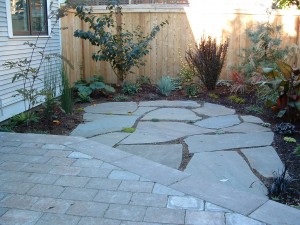
With the arrival of much needed rains, it seems that we may not have an Indian Summer in the Pacific Northwest this year. Another sure sign of fall, I saw the first mushroom of the season clinging to the root of a spent tomatoe plant when pulling it up to discard it. Some perennials in your garden may also be looking spent, but others, like Rudbeckia, many types of Salvia and Asters will continue to bloom until frost.
With shorter days and cooler temperatures ahead, it may seem like time to to turn the focus toward indoor activities. But any gardener knows, the real work of making gardens begins now. Fall is one of the the best times to evaluate your landscaping and make changes. Maybe you are ready for an overhaul or just want a new look. Some types of plants are best planted in the fall and will grow roots until the ground freezes so, come next summer, they need less water to thrive. Even if you don’t intend to take any action right away, fall and winter is a good time to plan changes to your garden to implement next spring. Taking pictures each season allows you look back and see what is working best, record your successes and watch your garden mature. Also note which areas need a boost in order to look better at this time next year. If you are working with a garden designer, sharing these images is a good way to start a conversation.
A garden that starts with structural plant elements (good bones) will look good all year long and may become the focus during late fall and winter when branches are bare, perennials are dormant and most blooming plants are not producing flowers. For beginners this is a good place to start and build from. Or, if your garden has never had a plan or lacks unity, looking at it through this lens may be eye opening and give you some ideas about where to focus on or where to get help.
With thousands of plants to choose from, it may seem like an overwhelming task to select plants that look good and support your overall landscape plan. Identifying the type plants you favor is a good place to start. With that information, a garden designer can figure out which ones will thrive in your garden and how those can fit into a cohesive plan.
I hope this blog post helps you get started thinking about enhancing your garden. If you are not a gardener or don’t have the time, you can work with a landscape designer to be able to enjoy the beauty and benefits of curated outdoors spaces.
Need more ideas? Contact me for a design consultation and learn about landscape design or the best plants for any spot in your garden.


